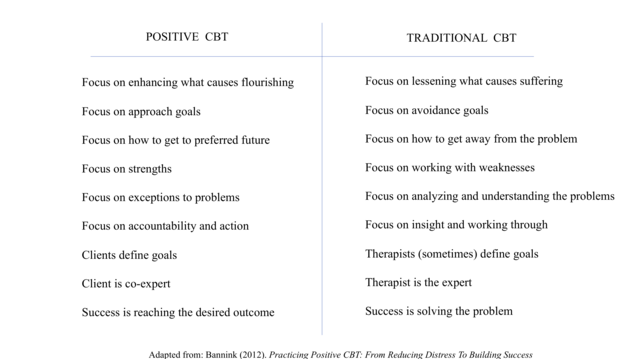Positive Psychology
Positive Psychology in Therapy: What is Positive CBT?
Learning how to be happy, not just how not to be unhappy.
Posted February 15, 2021

So concludes a series of recent studies that explored the effect of positive cognitive behavioral therapy (CBT) treatment compared to traditional CBT with outpatients with major depressive disorder. The participants of the studies received two blocks of treatment, with eight sessions of each therapy in random order. Not only did the participants report significant improvement of their depressive symptoms after receiving positive CBT, but they also preferred the more “enjoyable” and “motivating” positive CBT over traditional CBT. According to the authors of the studies, four key factors contributed to the success of the positive CBT sessions: feelings of empowerment, well-being boosting effects of positive emotions, learning to value small steps, and resurgence of optimism.
What Is Positive CBT?
Positive CBT integrates solution-focused brief therapy and positive psychology within a CBT framework to focus on the client’s strengths and preferred future. In positive CBT, the therapist invites the client to shift their attention to what works, rather than what doesn’t and to see the exceptions to the client’s problems, rather than the problem itself. An overarching premise in positive psychology is that well-being is not just the absence of psychopathology, but importantly, the presence of positive resources. Subsequently, positive CBT seeks to impart skills on how to be happy, not just how not to be unhappy.
Some of the main differences between traditional and positive CBT are outlined below.

In her three-decade career as a therapist, Dutch clinical psychologist Fredrike Bannink has frequently traveled to war-torn countries to work with organizations such as Doctors Without Borders. When it comes to trauma, she has seen it all. One of her observations about human beings is their penchant for resilience. “Most people do keep their heads above water, even in the bleakest circumstances. In fact, they are not only able to go on with their lives, but some even thrive after the worst is over,” she says.
Encouraged by the resilience-in-action she witnessed around the world, Dr. Bannink brought her insights to her clinical practice. What if, instead of focusing on symptom reduction and looking for ways to “fix” what was wrong, she could help her clients see what was working for them? What if she would shift away from problem-solving and move towards building strengths? What if instead of looking back, she could help her clients look forward to what might be created?
The interest in positive CBT continues to grow, as Bannink’s books get translated into different languages. Yet, as with any new paradigm, positive CBT has had its share of skepticism. Concerns range from the usual raised eyebrows that surround positive psychology interventions (“Am I supposed to stand in front of a mirror and tell myself that I’m doing great while I feel miserable?” one client quipped) to ignoring the problem (“With all the focus on the positive, how can the client feel heard about her very problem that has brought her to the therapist’s office in the first place?”).
These are common misconceptions, says Dr. Bannink.
“We do acknowledge the impact the problem has on the client’s life. But that’s very different from analyzing the problem and finding its causes. The therapist might say, I understand this must be hard for you. I also understand from what you are saying that you want things to be different. Is that correct? So, how would you like things to be different? And there’s the invitation to explore what people do want in their lives.”
How to help yourself: water the flowers, not the weeds
The positive CBT mindset can be learned by anyone. While it might take considerable training to make it a part of our well-being arsenal, we can start benefitting immediately from a conscious shift in where we habitually steer our attention. As William James famously wrote, “My experience is what I agree to attend to. Only those items which I notice shape my mind.”
Here are suggestions from Dr. Bannink on how to integrate positive CBT into everyday life.
1. Outline your goal
Be as detailed as possible. Describe your goal in positive, concrete, and realistic terms—what is it that you’d like to achieve, rather than what is it that you want to get rid of. Often, working with an approach goal motivates us more than working with an avoidance goal.
Some helpful questions to ask yourself might be:
- What does my preferred future look like?
- How will I know that I have achieved my goal?
- What will my thoughts, emotions, actions be like then?
- How will others close to me know that I am doing well?
2. Highlight the exceptions
Sometimes, we might become so consumed with our challenges that we don’t recognize the better moments embedded within our experiences. Exceptions to problems are always there, Dr. Bannink promises. Exploring these exceptions is crucial, because they will lead us to the solutions we are seeking.
Some helpful questions to ask yourself might be:
- What are the better moments?
- When is the problem less or even gone?
- When was the problem there, but I could cope a little better?
- When did I already see a glimpse of what I would like to see more of?
- What was my part in making these better moments happen?
- When do I see hope that better times are on the way?
3. Assess progress
Tracking our progress can provide us with crucial insights into our strengths and skills, while offering a glimpse into what we are already doing right.
Some helpful questions to ask yourself might be:
- On a scale of 10 to 0, where would I like to be in the future?
- What exactly does that number look like?
- How will I know that I have reached that number? How will others know?
- What number do I give my current situation?
- How come this number is not lower than it is?
- What is already/still working?
4. Cherish baby steps
Often, it’s the steady, small steps, rather than the big leaps, that take us to our goals. Identify the smallest of improvements. They are your roadmaps to success.
Some helpful questions to ask yourself might be:
- What is better, even just a little bit?
- What are some positive differences compared to a week ago?
- Which strengths did I use to take these small steps?
- What has been my part in reaching these improvements?
5. Celebrate
While it’s useful to keep our eyes on the road ahead, it’s important to pause and let our successes sink in. Acknowledge what you have accomplished and reward yourself for your positive qualities and hard work. If you find it difficult to see any progress, ask someone who is close to you. Sometimes, others are faster at noticing changes in us.
Some helpful questions to ask yourself might be:
- How will I reward myself for my progress?
- If you don’t notice progress, ask: How come things are not worse?
- How am I able to keep things stable?
The goal of positive CBT, explains Dr. Bannink, is to come close to your best possible outcome. Along the way, you might stumble upon other rewards that could ultimately be more important than the initial goal. You might gain emotion-regulating skills, awaken self-compassion, re-discover your optimism, rekindle your sense of hope and wonder, become your own best friend. You might realize that more things are possible than you ever thought before.

“Consider the metaphor of a garden,” says Dr. Bannink. “If you have a garden full of weeds, getting rid of all the weeds (an avoidance goal) will leave you with an empty space. Chances are that the weeds will grow back quickly. A beautiful garden requires more than taking out the weeds. It needs tending to the soil and planting seeds of all that you want to see. It needs sunshine as well as rain. When you have a lush and thriving garden, a few weeds once in a while will not cause you problems and will be easy to handle.”
References
Many thanks to Fredrike Bannink for her time and insights. Dr. Bannink is a clinical psychologist specializing in CBT, positive CBT, positive psychology and solution-focused brief therapy. She is the author of over 40 books, including Practicing Positive CBT: From Reducing Distress to Building Success (2012).
Bannink, F. & Geschwind, N. (2021). Positive CBT. Individual and group treatment protocols for positive cognitive behavioral therapy. Hogrefe Publishers.




